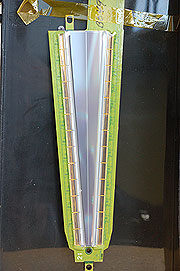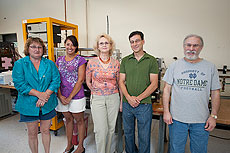Fermilab's SiDet Facility aides PHENIX detector upgrade

One of the hundreds of forward silicon vertex tracker (FVTX) components assembled at Fermilab's Silicon Detector Facility. Photo: Vassili Papavassiliou, New Mexico State University

The SiDet team completed the microassembly of FVTX components in mid-July. From left to right: Tammy Hawke, Michelle Jonas, Nina Ronzhina, Bert Gonzalez and Mike Herron. Also part of the group is Hogan Nguyen, not pictured. The FVTX group of PHENIX collaborators are also not pictured: Eric Mannel, Vassili Papavassiliou, Elaine Tennant, AAron Veicht and Dave Winter. Photo: Reidar Hahn.
PHENIX, one of two major experiments located at the Relativistic Heavy Ion Collider (RHIC) based at Brookhaven National Laboratory, is upgrading again with help from Fermilab's Slicon Detector Facility (SiDet). Fermilab technicians finished assembling hundreds of forward silicon vertex tracker (FVTX) detector components in early July.
The wedge-shaped components will be installed in PHENIX to help scientists study the properties of quark gluon plasma (QGP), which theorists believe made up the universe moments after the Big Bang.
Eric Mannel, a physicist from Columbia University and one of about 450 PHENIX contributors, worked as an electronics project engineer overseeing the final stages of assembly at Fermilab.
"We want to understand how the universe evolved the way it did from the very beginning," Mannel said. "The FVTX detector will provide a higher resolution for tracking of particles which will allow us to study the properties of QGP."
QGP is a near-perfect liquid composed of disassociated quarks and gluons suspended in plasma. It is said to be nearly perfect because it contains almost no internal friction-if you were to stir the plasma, it would continue to swirl forever. Physicists create QGP by smashing heavy ions and protons together. SiDet personnel provided a technical capabilities unique to Fermilab, to construct detectors that will allow physicists to study those collisions in more detail than ever before.
"We anticipate that we'll be able to reconstruct secondary vertices from the decay of charm and beauty quarks with a resolution of 70 microns. The typical decay lengths for those particles are several hundred microns in heavy-ion collisions at RHIC," Mannel said. The average human hair is about 100 microns thick.
AAron Veicht, a Ph.D. student at Columbia University, spent nearly 10 months working with the technicians at SiDet and will be part of the team installing the detector in PHENIX this fall.
"I'll get to see the project from the very early stages all the way through to analyzing the data, so it's very exciting," Veicht said. "I gained a lot of experience while working with the technicians at Fermilab. It was a vital part of my education."
Bert Gonzalez was the Fermilab technical supervisor on the design project.
"The process went quite well, as this was the first endeavor where we worked with program collaborators," Gonzalez said. Gonzalez and his Fermilab team spoke with PHENIX collaborators via conference calls for most of the design and development of the components.
"It was a good run," Gonzalez said. "The project will be missed at SiDet, because it was a concrete job; you could dig your hands into it."
Veicht felt that the people at SiDet were helpful and knowledgeable.
"It was my first time at Fermilab, and it was absolutely fantastic," Veicht said.
PHENIX collaborators plan to commission the detector in October and begin data collection this January.
- Ashley WennersHerron
|